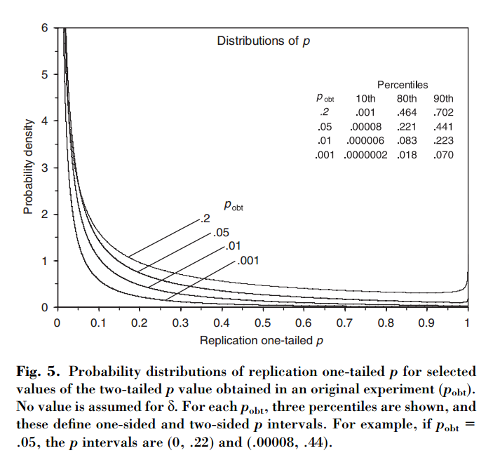I have been reading Geoff Cumming's 2008 paper Replication and $p$ Intervals: $p$ values predict the future only vaguely, but confidence intervals do much better [~200 citations in Google Scholar] -- and am confused by one of its central claims. This is one in the series of papers where Cumming argues against $p$-values and in favour of confidence intervals; my question, however, is not about this debate and only concerns one specific claim about $p$-values.
Let me quote from the abstract:
This article shows that, if an initial experiment results in two-tailed $p= .05$, there is an $80\%$ chance the one-tailed $p$-value from a replication will fall in the interval $(.00008, .44)$, a $10\%$ chance that $p < .00008$, and fully a $10\%$ chance that $p > .44$. Remarkably, the interval—termed a $p$ interval—is this wide however large the sample size.
Cumming claims that this "$p$ interval", and in fact the whole distribution of $p$-values that one would obtain when replicating the original experiment (with the same fixed sample size), depend only on the original $p$-value $p_\mathrm{obt}$ and do not depend on the true effect size, power, sample size, or anything else:
[...] the probability distribution of $p$ can be derived without knowing or assuming a value for $\delta$ (or power). [...] We do not assume any prior knowledge about $\delta$, and we use only the information $M_\mathrm{diff}$ [observed between-group difference] gives about $\delta$ as the basis for the calculation for a given $p_\mathrm{obt}$ of the distribution of $p$ and of $p$ intervals.
I am confused by this because to me it seems that the distribution of $p$-values strongly depends on power, whereas the original $p_\mathrm{obt}$ on its own does not give any information about it. It might be that the true effect size is $\delta=0$ and then the distribution is uniform; or maybe the true effect size is huge and then we should expect mostly very small $p$-values. Of course one can start with assuming some prior over possible effect sizes and integrate over it, but Cumming seems to claim that this is not what he is doing.
Question: What exactly is going on here?
Note that this topic is related to this question: What fraction of repeat experiments will have an effect size within the 95% confidence interval of the first experiment? with an excellent answer by @whuber. Cumming has a paper on this topic to: Cumming & Maillardet, 2006, Confidence Intervals and Replication: Where Will the Next Mean Fall? -- but that one is clear and unproblematic.
I also note that Cumming's claim is repeated several times in the 2015 Nature Methods paper The fickle $P$ value generates irreproducible results that some of you might have come across (it already has ~100 citations in Google Scholar):
[...] there will be substantial variation in the $P$ value of repeated experiments. In reality, experiments are rarely repeated; we do not know how different the next $P$ might be. But it is likely that it could be very different. For example, regardless of the statistical power of an experiment, if a single replicate returns a $P$ value of $0.05$, there is an $80\%$ chance that a repeat experiment would return a $P$ value between $0$ and $0.44$ (and a $20\%$ change [sic] that $P$ would be even larger).
(Note, by the way, how, irrespective of whether Cumming's statement is correct or not, Nature Methods paper quotes it inaccurately: according to Cumming, it's only $10\%$ probability above $0.44$. And yes, the paper does say "20% change". Pfff.)



